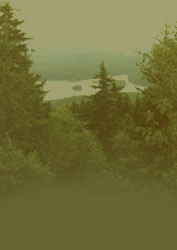|
Do you have something
happening in your corner of Washington? - Please call a member
or e-mail your observations to have them included here
This Month:
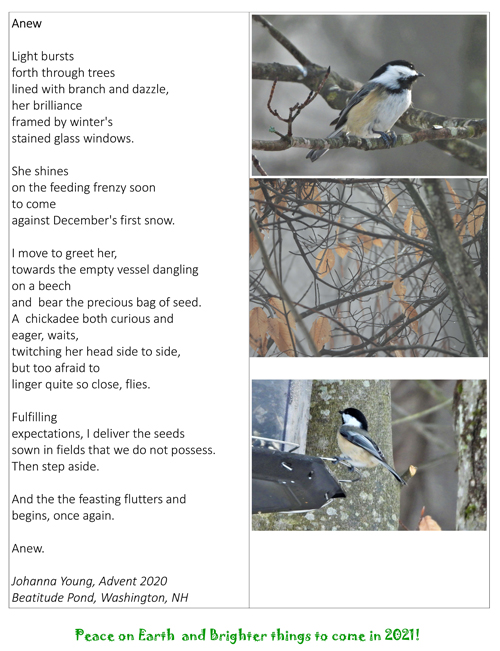
Advent Poem by Johanna Young
Merry Christmas, Happy Solstice and Seasons Greetings from the Conservation Commission members!!
November:
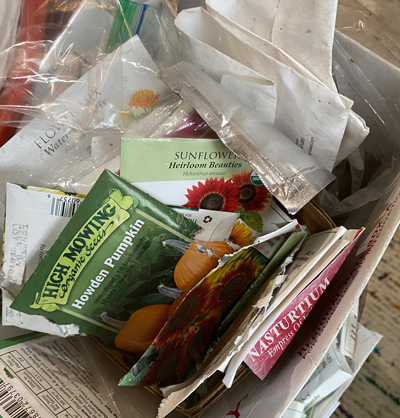
Photo by Nan Schwartz
Whether you save seeds or just have some left over at the end of the season, it’s important to keep them in the right conditions to ensure their viability for the next season.
It is essential to keep seeds dry and cool so that they will remain viable until the next spring. Ideally, they should be stored in tightly sealed glass containers. Individual varieties or different types of seeds can be placed inside of paper packets and then packed together inside of a larger glass container. A good temperature range for storage is between 32° and 41°F, making the refrigerator a good place for keeping seeds.
Humidity can sometimes be an issue inside of containers, so adding a desiccant can be helpful. A small amount of silica-gel from a craft supply store or powdered milk wrapped in tissue or cheese cloth will absorb moisture and keep seeds dry.
Finally, make sure to carefully label seeds before you put them into storage. At minimum, note their name, variety and the date you collected them. Aim to use saved seeds within a year, as older seeds do not germinate as well and are not as vigorous.
This information and more found at UNH Cooperative Extension
October:
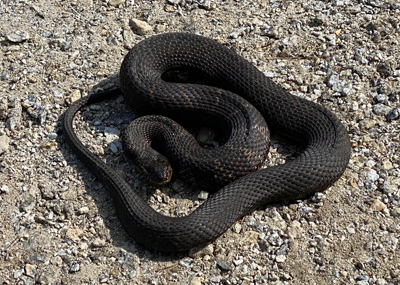
Photo by Jed Schwartz
Jed was passing the pond at the Eccardt Farm when he spotted a large Northern Water Snake! This dark-colored, rough-skinned snake has a big reputation and, since it’s commonly seen basking and swimming at local ponds, lakes, and rivers from spring through early fall, we have many opportunities to observe and interact with it.
Northern water snakes are part of the complex and diverse system of living organisms that make up New Hampshire’s freshwater wetlands.
Knowing the facts about these unique reptiles might help you feel more comfortable about coexisting with them. Here are a few things to keep in mind the next time you’re lucky enough to see one:
Is it venomous?
No. New Hampshire is home to only one venomous snake, the timber rattlesnake, which is exceptionally rare and is protected by law. Northern water snakes — and any other snake species you are likely to find in or near water in the Granite State — are not venomous.
Will it bite me?
This is not the species to help you hone your snake-catching skills! If you leave it be, it will leave you be, but Northern water snakes do respond aggressively when confronted. The good news is that they will give you ample notice that they’re agitated by flattening their body and jaws, releasing a noxious musk as a warning, and generally trying to convince you that handling them is not worth the trouble. I’ve shared a swimming hole with this snake for years, and the only time I’ve ever seen it bite was when someone was trying to pick it up.
What does it eat?
The Northern water snake is a scavenger and hunter of small critters. Its diet consists of tadpoles, frogs, salamanders, fish (both alive and dead), crayfish, large aquatic insects, small turtles, birds, and occasionally rodents and other snakes. If you don’t like leeches, thank a Northern water snake for eating one for lunch!
New Hampshire Fish and Game’s Nongame and Endangered Wildlife Program is always interested in knowing where you see this snake and other reptiles. Share your sightings of Northern water snake by participating in the Reptile and Amphibian Reporting Program (RAARP) at New Hampshire Wildlife Sightings.
Information found at Keene Sentinel
September:

Photo by Jed Schwartz
The autumnal equinox — also called the September or fall equinox — is the astronomical start of the fall season in the Northern Hemisphere and of the spring season in the Southern Hemisphere. This year the equinox is on September 22nd.
The word “equinox” comes from Latin aequus, meaning “equal,” and nox, “night.” On the equinox, day and night are roughly equal in length.
During the equinox, the Sun crosses what we call the “celestial equator”—an imaginary extension of Earth’s equator line into space. The equinox occurs precisely when the Sun’s center passes through this line. When the Sun crosses the equator from north to south, this marks the autumnal equinox; when it crosses from south to north, this marks the vernal equinox. A more precise equinox event is that the Sun rises and sets exactly in the east and west on this day.
Based on the astronomical definition of seasons, the autumnal equinox marks the first day of fall (in the Northern Hemisphere).
After the autumnal equinox, the Sun begins to rise later and nightfall comes sooner. This ends with the December solstice, when days start to grow longer and nights shorter.
There’s an old-wife’s tale that you can stand an egg on its end of the equinox. Well, yes, it’s true (and fun to try).
The full Moon closest to the September equinox is the Harvest Moon. This year, due to the timing of the equinox, it falls on Thursday, October 1.
Welcome to fall!
Information found at Old Farmer's Almanac
August:
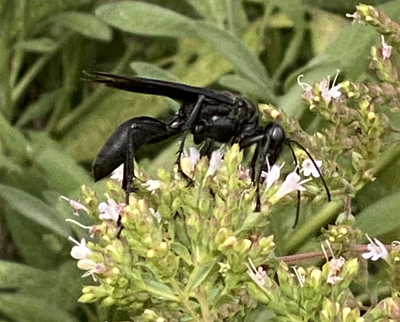
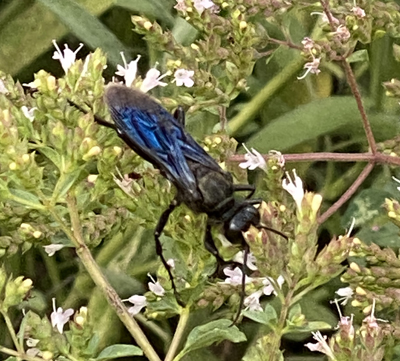 Great Black Wasp photos by Jed Schwartz
Great Black Wasp photos by Jed Schwartz
The iridescent Great Black Wasp pollinates flowers while feeding itself, and removes plant pests while feeding its young making it a great friend to gardens and fields.
Steely blue-black, large (1 to 1.5”) and with iridescent wings, the Great Black Wasp is a nectar and pollen eater. It can be seen visiting flowers in the hottest parts of the summer and early fall and helps pollinate plants. Every adult, however, was raised on a diet of Katydids and their relatives, Grasshoppers or Crickets.
Great Black Wasps are part of the Digger Wasp family, creating burrows in the soil. Adult female wasps hunt for insects after laying fertilized eggs in this underground nest. Each egg laid in a tunnel and a Katydid or Cricket is placed next to it. Once the egg hatches, the emerging larva has an immediate food source and will devour the insect as it grows and develops. This juvenile diet helps keep the katydid, cricket and grasshopper populations under control in areas where Great Black Wasps are present.
Adult Great Black Wasps may look mean, but they are disinterested in humans and are not bothersome. That said, they can sting if mishandled or threatened, so looking is safer than touching. They are helpful pollinators, a friend to gardeners and fascinating to watch.
Information found at Insectidentification.org
July:
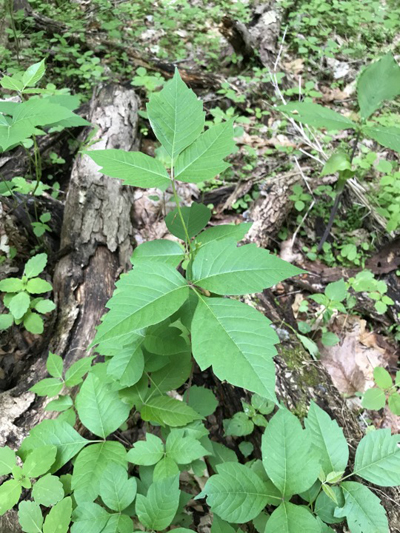
Poison Ivy photo by Carnegie
You’ve likely heard of the saying “leaves of three, let it be,” and that’s certainly helpful when it comes to spotting Poison Ivy: The plant, indeed, is characterized by a triumvirate of leaves that start out red in the spring, turn green in the summer, and then yellow, orange, or red in the fall. Trouble is, it’s not the only plant that’s three-leafed. Boxelder, young Virginia creepers, and, yes, strawberries, all have three leaves per stem and are often mistaken for poison ivy.
To complicate matters, there are dozens of poison ivy species. Some have tiny leaves, others large. Some grow as ground cover, others as low shrubs, and still others as climbing vines. Leaves can be toothed or smooth. And they may or may not have a glossy appearance.
In the summer, the weed may produce clusters of tiny yellow-green flowers, which later develop into whitish berries. Cute, right? Only if you’re a bird who likes to snack on these berries. In the winter, the berries may still be around but not the leaves, making it especially difficult to identify the plant.
A rash occurs wherever skin touches urushiol, the oil on poison ivy that triggers the immune system to attack the skin. Even if the rash is severe and the blisters break, the fluid in the blisters isn’t contagious; there’s no urushiol in it. If a rash spreads to a different part of the body, it’s often due to scratching with fingernails that have oil stuck under them. About 15 percent of the population is immune to the effects of urushiol. Getting a rash from poison ivy doesn’t inoculate you against the next exposure. In fact, it means your next rash will likely be worse, because your immune system will have gotten better at recognizing urushiol. Only humans and a few primates are allergic to urushiol. Every other animal is immune. You still need to be careful with your pets, though, if they’ve been in contact with poison ivy; they may have gotten some of its oil on their fur, which, if it ends up touching your skin, can trigger a rash on you.
And even when poison ivy is dead and there are no leaves left, there’s still urushiol on the stems and roots. It’s not uncommon for people to unknowingly come in contact with urushiol in the winter, say, by chopping wood that once had poison ivy growing on it.
Information found at Gardenista.com
June:
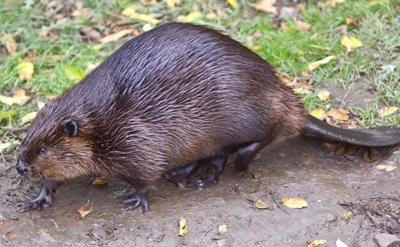
Beaver photo by Ontario Parks

Muskrat photo by Missouri Department of Conservation Staff
Do muskrats and beavers actually live together in the same lodge?
Muskrats and beavers prefer to live in wetland areas where the water level stays constant. Beavers can build dams to ensure a steady water depth. Muskrats can’t. Their territory benefits from the beaver’s presence.
Muskrats, with their small, slender bodies, can easily navigate the cattail forest that grows in a marsh. The much larger beaver cannot. As the muskrats feed on cattails they clear channels that the beaver can easily navigate.
Both of the rodents build lodges using marsh materials. Muskrats pile up plants, such as cattails, and add a bit of mud to hold everything together. Beavers use a lot of mud to glue branch pieces together. Occasionally a muskrat may take up residence in a beaver dam. Since another pair of watchful eyes is always welcome, the muskrat’s presence is tolerated by the beaver family.
Although both species are both active in the evening they stay out of each other’s way. Muskrats sit on their feeding platforms munching on plants collected in the marsh. Beavers move to the shore, take down trees surrounding the marsh then munch on the delectable branches and twigs. Unlike Beavers, Muskrats supplement their diet of plants with frogs, crayfish, clams, snails, and fish. It may be that when cohabiting a lodge, they may help one another keep an eye out for predators.
Information found at Sarett Nature Notebook
April:
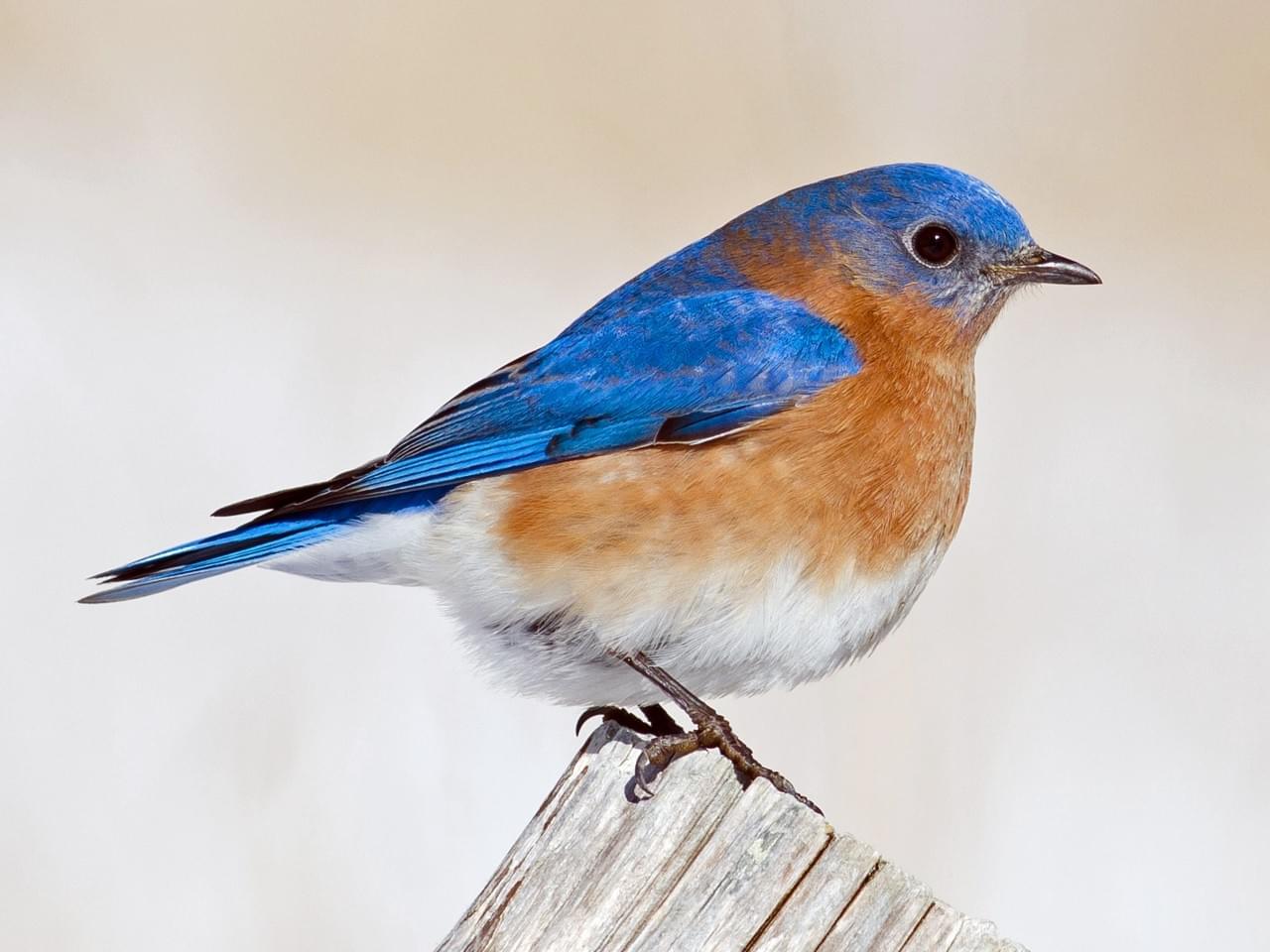
Photo by Alix d'Entremont
You can find Eastern Bluebirds in open country with patchy vegetation and large trees or nest boxes. Meadows, old fields, and golf courses are good places. Bluebirds typically sit in the open on power lines or along fences, with an alert, vertical posture. When they drop to the ground after an insect, they make a show of it, with fluttering wings and a fairly slow approach, followed by a quick return to the perch.
Cool Facts
• The male Eastern Bluebird displays at his nest cavity to attract a female. He brings nest material to the hole, goes in and out, and waves his wings while perched above it. That is pretty much his contribution to nest building; only the female Eastern Bluebird builds the nest and incubates the eggs.The female makes the nest by loosely weaving together grasses and pine needles, then lining it with fine grasses and occasionally horse hair or turkey feathers.
• Eastern Bluebirds typically have more than one successful brood per year. Young produced in early nests usually leave their parents in summer, but young from later nests frequently stay with their parents over the winter.
• Eastern Bluebirds occur across eastern North America and south as far as Nicaragua. Birds that live farther north and in the west of the range tend to lay more eggs than eastern and southern birds.
• Eastern Bluebirds eat mostly insects, wild fruit and berries. Occasionally, Eastern Bluebirds have also been observed capturing and eating larger prey items such as shrews, salamanders, snakes, lizards and tree frogs.
You can attract Bluebirds to your yard by providing nest boxes where they can build their nests and raise their young. Here is a simple plan for a nest box that you can make from left over lumber: Bluebird Nest Box Plan
Information and plan found at Cornell University - All About Birds
January:

Photo by Nan Schwartz
January is when we start to find seed catalogs in our mailbox. Now is a great time to select and order flower and vegetable seeds for your next garden. Ordering early ensures that you will get the seeds you want and have them on hand when it’s time to start planting. Remember to purchase seed from reliable companies based in the northeast in order to grow plants that are adapted to the climate in New Hampshire. It’s always fun try some new varieties along with all of your old favorites.
Many new vegetable and flower varieties are hybrids, meaning that they are the result of hand-pollinating two different parent varieties. Hybrid varieties often have more vigor and uniformity, and they may cost more than open-pollinated varieties. Some hybrids offer specific disease resistance or other unique cultural characteristics.
Although some seeds will keep for several years if stored properly, they suggest buying only enough seeds for the current year’s use. Seed suppliers perform germination tests to determine the viability of seeds before sale. Printing on the seed packet usually indicates the date of the germination test and percentage of seed that germinated, as well as any chemical seed treatments that may have been applied, and other essential information.
If you get your seeds well in advance of the actual planting date or are attempting to store surplus seeds, keep them in a cool, dry place.
Laminated foil packets help ensure dry storage. Paper packets are best kept in tightly closed jars or containers and maintained around 40°F with low humidity.
Some gardeners save seeds from their own gardens; however, such seeds may be the result of random pollination by insects or other natural agents and may not produce plants like the parent plants. Those interested in saving seeds should stick with open-pollinated varieties, because seed saved from hybrids does not “breed true”; the next generation won’t look exactly like the original variety.
Learn how to start plants from seed here: UNH Extension
Sign up to get Emma Erler’s monthly newsletter “Outside with Emma Erler” here: Emma Erler's Newletter
Don’t forget, if you don’t have room to garden at home you can join the Community Garden and get a plot to plant! Contact Arin Mills for more information: Click here to email Arin.
To view yearly archives of our "New In
Nature" series click on year you wish to see.
2002
2003
2004
2005
2006
2007
2008
2009
2010
2011
2012
2013
2014
2015
2016
2017
2018
2019
|


